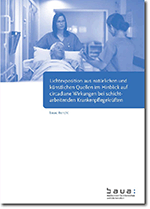Good lighting in the workplace is intended to help workers see well, prevent accidents, and excessive eye strain.
Good lighting in the workplace is intended to help workers see well, prevent accidents, and excessive eye strain. Employees’ safety and health therefore depend in part on the illumination of their environments at work. In this context, apart from the classic visual factors such as visual acuity and visual comfort, occupational safety and health is also focussing to a greater extent on the non-visual effects of daylight and artificial light.
Light for good visibility
Workplace lighting is essential to the visual process and the prevention of accidents caused by poor visibility, while excessive strain on the eyes is to be avoided. Insufficient light levels, glare, or uneven illumination may, for example, cause mental strain, visual fatigue, a deterioration in performance, and a higher risk of errors and/or accidents. Good illumination accordingly helps to promote activity and well-being among staff members, which has positive impacts on their performance and commitment.
The occupational safety and health requirements regarding the lighting of workplaces primarily relate to aspects of visual performance and the avoidance of visual discomfort and visual fatigue. The protection targets to be achieved with regard to the lighting of working environments are defined in the Workplaces Ordinance (Arbeitsstättenverordnung, ArbStättV), the requirements of which are given concrete form by Technical Rules for Workplaces (Technische Regeln für Arbeitsstätten, ASRs). The ASR A3.4 sets out the requirements placed on the illumination of workplaces with daylight and artificial lighting. ASR A2.3 specifies requirements for the illumination of escape routes and emergency exits.
Non-visual effects of light
Apart from the visual effects of light, its contributions to visual performance and visual comfort for instance, occupational safety and health is paying ever more attention to the non-visual effects of light. These are the effects light has on individuals’ physiology, mood, and behaviour. In recent years the research into the non-visual effects of light has increasingly established direct links between light and health. The non-visual effects of light are also closely connected with factors that affect mental health in the work domain.
The discovery of a previously unknown kind of photoreceptor in the human eye that is sensitive to blue light marked the starting point for an intensification of research into the non-visual effects of light around the turn of the millennium. When these cells are stimulated by blue/cyan parts of the light spectrum, the body is switched into an attentive, alert state. This activation is caused naturally by daylight, but can also be triggered by artificial light. Laboratory-based fundamental research has already established a solid foundation of findings about such effects of light, their connections with human circadian rhythms for example. There is currently intensive discussion about how these new findings should be incorporated into workplace lighting concepts. Further information on these discussions can be found in the position paper on the treatment of artificial, biologically efficient illumination in standards that has been published by the Commission for Occupational Health and Safety and Standardisation (Kommission Arbeitsschutz und Normung, KAN).
Daylight
With its high intensity and large amounts of light in the blue-appearing part of the spectrum, natural daylight produces the non-visual effects of light discussed above and supplies the biological clock with the information it needs about the time of day. Daylight consequently makes it possible for important body functions to be synchronized and adjusted to the external environment. For example, the body uses the information supplied by light to regulate its core temperature and control the release of stress hormones in the morning. As light’s direct counterpart, the darkness of the evening and night allows the unrestricted production of “night hormones” and their release into the bloodstream, thus ensuring individuals are able to rest and recuperate overnight. These effects are closely linked to human health. Efforts should therefore be made to ensure that workplaces get plenty of daylight and unnecessary exposure to light is avoided in the evenings and at night. As far as the future of lighting design for workplaces is concerned, it will be important to gain an even better understanding of the interactions between daylight and artificial illumination, and how they influence employees’ safety and health.



